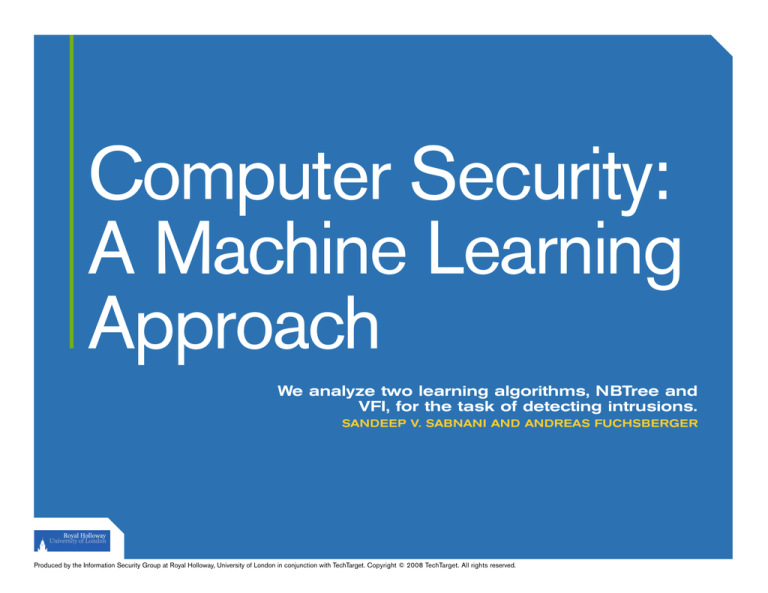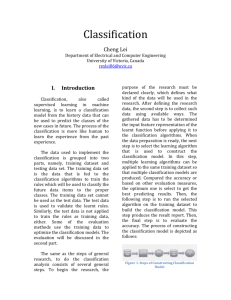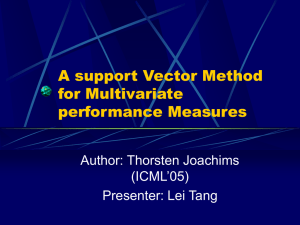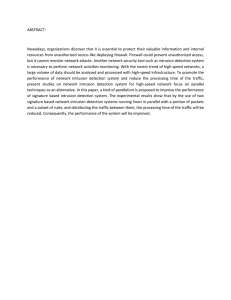
Computer Security:
A Machine Learning
Approach
We analyze two learning algorithms, NBTree and
VFI, for the task of detecting intrusions.
SANDEEP V. SABNANI AND ANDREAS FUCHSBERGER
Produced by the Information Security Group at Royal Holloway, University of London in conjunction with TechTarget. Copyright © 2008 TechTarget. All rights reserved.
Royal Holloway series
Machine learning approaches
ABSTRACT
Information Security is one of the key areas today as securing computers especially
against novel attacks becomes a daunting task. Intrusion detection is a method by which
unauthorised access to one’s assets is detected. In this paper, we present an application
of the field of machine learning to computer security, particularly to intrusion detection.
We analyse two learning algorithms (NBTree and VFI) for the task of detecting intrusions
and compare their relative performances. We then comment on the suitability of NBTree
algorithm over VFI for the intrusion detection task based on its high accuracy and high
recall. We finally state the usefulness of machine learning to the field of computer security.
Computer Security:
A Machine Learning Approach
1. INTRODUCTION
Computer security has become a chal-
lenging task these days with the rapid
growth of the internet and the increasing
complexity of communication protocols.
New and complicated attack methods are
being constantly developed by attackers
thereby compromising the confidentiality,
integrity and/or availability of one’s data.
CERT has reported 8064 new vulnerabilities in the year 2006 and the number has
been increasing significantly over the past
few years [1].
• MACHINE LEARNING
There have been quite a few approaches
which prevent and/or detect known attacks.
Novel or unknown attacks on the other hand
are more difficult to detect and have received
considerable attention in the recent past.
Another important problem in the field of
computer security has been that of insider
threats. Many of the insider threats may be
unintentional, nevertheless it has become
essential to ensure that insider behaviour
is in sync with the security policy of the
organisation.
These issues can prove to be quite expen-
• COMPUTER SECURITY
APPLICATIONS
• EVALUATION
Sandeep V.
Sabnani
Information Security Group
Royal Holloway, University of London
Egham, Surrey, TW20 0EX,
United Kingdom
s.sabnani@rhul.ac.uk
Andreas
Fuchsberger
Information Security Group
Royal Holloway, University of London
Egham, Surrey, TW20 0EX,
United Kingdom
a.fuchsberger@rhul.ac.uk
This article was prepared by students and
staff involved with the award-winning M.Sc.
in Information Security offered by the
Information Security Group at Royal Holloway,
University of London. The student was judged
to have produced an outstanding M.Sc. thesis
on a business-related topic. The full thesis
is available as a technical report on the
Royal Holloway website
http://www.ma.rhul.ac.uk/tech.
For more information about the Information
Security Group at Royal Holloway or on the
M.Sc. in Information Security, please visit
http://www.isg.rhul.ac.uk.
• CONCLUSIONS
2
Royal Holloway series
Machine learning approaches
sive for organisations to handle. The task
of detecting intrusions involves the formulation of efficient rules which require a high
level of domain expertise and analysis of
large amounts of data, which might make
the process slow and unreliable with human
experts. For checking compliance with a
security policy, an administrator may have
to be extremely cautious as normal user
behaviour may change over time.
Machine learning is a field related to artificial intelligence which deals with constructing computer programs that automatically
improve with experience [12]. The learning
experience is provided in the form of data
and actual learning is achieved with the help
of algorithms. The two main tasks that are
addressed by machine learning are the
ability to learn more about the given data
and to make predictions about new data
based on learning outcomes from the learning experience [9]; both of which are difficult
and time-consuming for human analysts.
Machine learning is thus, well-suited to
problems that depend on rare, expensive
and unreliable human experts.
This paper presents the intrusion detection problem and a machine learning based
solution to it.
• MACHINE LEARNING
2.
MACHINE LEARNING
2.1 Basic Concepts
Learning can be described in many ways
including acquisition of new knowledge,
enhancement of existing knowledge, representation of knowledge, organisation of
knowledge and discovery of facts through
experiments [11]. When such learning is performed with the help of computer programs,
it is referred to as machine learning.
Every computer action can be modeled
as a function with sets of inputs and outputs.
A learning task may be considered as the
estimation of this function by observing the
sets of inputs and outputs. (We use the term
estimation as the exact function may not
be determinate.) The function estimating
process usually consists of a search in the
hypothesis space (i.e. the space of all such
possible functions that might represent the
input and output sets under consideration).
The authors in [14] formally describe the
function approximation process. Consider a
set of input instances X = ( x1, x2, x3 . . . xn).
Let f be a function which is to be guessed
by the learner. Let h be the learner’s
hypothesis about f.
Also, we assume a priori that both f and h
belong to a class of functions H. The function
• COMPUTER SECURITY
APPLICATIONS
• EVALUATION
Every computer
action can
be modeled
as a function
with sets of
inputs and
outputs.
• CONCLUSIONS
3
Machine learning approaches
Royal Holloway series
f maps the input instances in X as,
X h→H h(X)
∋
A machine learning task may thus be
defined as a search in this space H. This
search results in approximating the relevant
h, based on the training instances (i.e. the
set X).
The approximation is then checked against
a set of test instances which are then used
to indicate the correctness of h. The search
requires algorithms which are efficient and
which best-fit the training data [12].
an important issue for machine learning. The
learning element may be trained in different
ways [3]. For classification problems like intrusion detection, knowledge may be learned in
a supervised, unsupervised or semi-supervised manner. In this paper, we use supervised learning in which the learner is provided
with training examples with the associated
classes or values for the attribute to be
predicted.
Choosing a learning
algorithm
2.2 Inputs and Outputs
The inputs and outputs to a machine
learning task may be of different kinds.
Generally, they are in the form of numeric or
nominal attributes. For instance, an attribute
like temperature if used as a numeric attribute, may have values like 25o C, 28o C, etc.
On the other hand, if it is used as a nominal
attribute, it may take values from a fixed set
(like high, medium, low). In many cases, the
output may also be a boolean value (like yes
and no).
2.3 Production of Knowledge
The way in which knowledge is learned is
• MACHINE LEARNING
The inputs and
outputs to a
machine learning
task may be of
different kinds.
Training the algorithm
using training data
Evaluating the algorithm
by running it on test data
Figure 1. Life Cycle of a Machine Learning Task
2.4 Defining a Machine Learning Task
In general, a machine learning task can be
defined formally in terms of three elements,
viz. the learning experience E, the tasks T
and the performance element P.
TM Mitchell in Machine Learning [12]
• COMPUTER SECURITY
APPLICATIONS
• EVALUATION
• CONCLUSIONS
4
Royal Holloway series
Machine learning approaches
defines a learning task more precisely as
follows:
“A computer program is said to learn from
experience E with respect to some class of
tasks T and performance measure P, if its
performance at tasks in T, as measured
by P, improves with experience E.”
2.5 Life Cycle of a Machine
Learning Task
Figure 1 shows the life cycle of a machine
learning task. Depending on the nature of
the knowledge to be learned, different
types of algorithms may be chosen at
different times. Also, the type of inputs
and outputs are also instrumental in
choosing an algorithm.
Once the algorithm is selected, the next
step is to train the algorithm by providing it
with a set of training instances. The training
instances are used to build a model that represents the target concept to be learned (i.e.
the hypothesis). This model is then evaluated
using the set of test instances.
In the case where a large amount of data
is available, the general approach is to construct two independent sets, one for training
and the other for testing. On the other hand,
if a limited amount of data is available, it
• MACHINE LEARNING
becomes difficult to create separate sets
for training and testing. In such cases, some
data might be held over for testing, and the
remaining used for training. This is called the
holdout procedure [20]. However, the data in
this case might be distributed in an uneven
way in the training and test sets and might
not represent the output classes in the
correct proportions. Stratification [4] and
cross-validation [5] can be used to
circumvent this problem.
2.6 Benefits of Machine Learning
The field of machine learning has been
found to be extremely useful in the following
areas relating to software engineering [12]:
1. Data mining problems where large
databases may contain valuable implicit regularities that can be discovered automatically.
2. Difficult to understand domains where
humans might not have the knowledge to
develop effective algorithms.
3. Domains in which the program is
required to adapt to dynamic conditions.
Once the
algorithm is
selected, the
next step is to
train the algorithm
by providing it
with a set of
training instances.
In the case of traditional intrusion detection systems, the alerts generated are
analysed by human analysts who evaluate
them and take suitable actions. However,
• COMPUTER SECURITY
APPLICATIONS
• EVALUATION
• CONCLUSIONS
5
Royal Holloway series
Machine learning approaches
this is an extremely onerous task as the
number of alerts generated may be quite
large and the environment may change
continuously [16]. This makes machine
learning well suited for intrusion detection.
3. MACHINE LEARNING APPLIED
TO COMPUTER SECURITY
3.1 Intrusion Detection as
a Machine Learning Task
A machine learning task can be formally
defined as shown in section 2.4. We use
this notation to formulate intrusion detection
as a machine learning task.
Thus, for intrusion detection, we have,
1. Task: To detect intrusions in an
accurate manner.
2. Experience: A dataset with instances
representing normal as well as attack data.
3. Performance Measure: Accuracy
in terms of correct classification of intrusion events and normal events and other
statistical metrics including precision,
recall, F-measure and kappa statistic
which are described in section 3.5.
set for intrusion detection obtained from the
UCI machine learning repository. The KDD
Cup ’99 data set is a version of a data set
used at the DARPA Intrusion Detection
Evaluation program (www.ll.mit.edu/IST/
ideval/data/data index.html).
The data set consists of TCP dump data
for a simulated Air Force LAN. In addition to
normal LAN simulation, attacks were also
simulated and the corresponding TCP data
was captured. The attacks were launched
on three UNIX machines, Windows NT
hosts and a router along with background
traffic. Every record in the data set represents a TCP connection. Each connection
was labeled as normal or as a specific
attack type [15]. The attacks fall into one
of the following categories:
• DOS attacks (Denial of Service attacks)
• R2L attacks (unauthorised access from
a remote machine)
• U2R attacks (unauthorised access to
super user privileges)
• Probing attacks
In addition to
normal LAN
simulation,
attacks were also
simulated and the
corresponding
TCP data was
captured.
A detailed description and format of the
dataset can be found in [17].
3.2 Data Set Description
The data set used for evaluation in this
paper is a subset of the KDD Cup ’99 data
• MACHINE LEARNING
• COMPUTER SECURITY
APPLICATIONS
• EVALUATION
• CONCLUSIONS
6
Royal Holloway series
Machine learning approaches
3.3 Algorithms
3.3.2 VFI
The following algorithms were used in the
experiments carried out for this paper.
3.3.1 NBTree
The NBTree algorithm is a hybrid between
decision-tree classifiers and Naive Bayes
classifiers. It represents the learned knowledge in the form of a tree which is constructed
recursively. However, the leaf nodes are
Naive Bayes categorizers rather than nodes
predicting a single class [6]. For continuous
attributes, a threshold is chosen so as to
limit the entropy measure. The utility of a
node is evaluated by discretizing the data
and computing the fivefold cross-validation
accuracy estimation using Naive Bayes at
the node. The utility of the split is the weighted
sum of utility of the nodes and this depends
on the number of instances that go through
that node. The NBTree algorithm tries to
approximate whether the generalisation
accuracy of Naive Bayes at each leaf is
higher than a single Naive Bayes classifier
at the current node. A split is said to be
significant if the relative reduction in error
is greater that 5% and there are at least
30 instances in the node [6].
• MACHINE LEARNING
The VFI4 algorithm is a classification
algorithm based on the voting frequency
intervals. In VFI, each training instance is
represented as a vector of features along
with a label that represents the class of
the instance. Feature intervals are then
constructed for each feature. An interval
represents a set of values for a given feature
where the same subset of class values
are observed. Thus, two adjacent intervals
represent different classes.
A detailed explanation of both the above
algorithms can be found in [17].
The NBTree
algorithm is a
hybrid between
decision-tree
classifiers and
Naive Bayes
classifiers.
3.4 Experimental Analysis
The experiments done in this paper
consist of the evaluation of the performance
of NBTree and VFI algorithms for the task
of classifying novel intrusions. The dataset
described in section 3.2 was used in the
experiments.
Weka [20], a machine learning toolkit was
used for the implementation of the algorithms described in sections 3.3.1 and
3.3.2. Due to the limitation in the available
memory and processing power, it was not
possible to use the full dataset described in
section 3.2. Instead a reduced subset was
• COMPUTER SECURITY
APPLICATIONS
• EVALUATION
• CONCLUSIONS
7
Machine learning approaches
Royal Holloway series
used and 10-fold cross-validation (explained
in section 2.5) was used to overcome this
limitation.
3.5 Evaluation Metrics
In order to analyse and compare the
performance of the above mentioned
algorithms, metrics like the classification
accuracy, precision, recall, F-Measure and
kappa statistic were used. These metrics are
derived from a basic data structure known
as the confusion matrix. A sample confusion
matrix for a two-class problem is shown in
Table 1.
Predicted
Class
Positive
Predicted
Class
Negative
Actual Class
Positive
a
b
Actual Class
Negative
c
d
3.5.1 Classification Accuracy
Classification accuracy is the most basic
measure of the performance of a learning
method. It determines the percentage of
correctly classified instances. From the
confusion matrix, we can say that:
Accuracy = a+d
a+b+c+d
In the context
of intrusion
detection, a
true positive is
an instance which
is normal and is
also classified
as normal by the
intrusion detector.
This metric gives the number of instances
from the dataset which are classified correctly
i.e. the ratio of true positives and true negatives to the total number of instances.
3.5.2 Precision, Recall and F-Measure
Table 1. Confusion Matrix for a two-class
problem (Expected predictions)
In this confusion matrix, the value a is called
a true positive and the value d is called a true
• MACHINE LEARNING
negative. The value b is referred to as a false
negative and c is known as false positive.
In the context of intrusion detection, a true
positive is an instance which is normal and
is also classified as normal by the intrusion
detector. A true negative is an instance
which is an attack and is classified as an
attack.
Precision gives the percentage of slots
in the hypothesis that are correct, whereas
recall gives the percentage of reference
slots for which the hypothesis is correct.
• COMPUTER SECURITY
APPLICATIONS
• EVALUATION
• CONCLUSIONS
8
Royal Holloway series
Machine learning approaches
figure and deducts it from the predictor’s
success and expresses the result as a proportion of the total for a perfect predictor [20].
In addition to the above statistical metrics,
the time taken to build the model was also
considered as a performance indicator.
Referring from the confusion matrix, we
can define precision and recall for our
purposes as [19]:
Precision = a
a+c
Recall = a
a+b
3.6 Attribute Selection
The precision of an intrusion detection
learner would thus indicate the proportion of
correctly classified positive instances to the
total number of predicted positive instances
and recall would indicate the proportion of
correctly classified positive instances to the
total number of actual positive instances.
The F-measure is another metric defined
as the weighted harmonic mean of precision
and recall [8] to address a problem identified
in [7], which may be present in any classification scenario.
F-measure = 2*Precision*Recall
Precision+Recall
3.5.3 Kappa Statistic
The Kappa statistic is used to measure
the agreement between predicted and
observed categorizations of a dataset, while
correcting for agreements that occur by
chance. It takes into account the expected
• MACHINE LEARNING
Attribute Selection is the process of
identifying and removing much of the redundant and irrelevant information possible. The
experiments conducted in this paper use the
information gain attribute selection method
which is described in [17].
3.7 Summary of Experiments
Based on the above algorithms, attribute
selection methods and the type of cross-validation, the following table 2 shows a summary
of the experiments conducted.
Algorithm
Feature Reduction
Method
Cross
Validation
NBTree
—
10-fold
VFI
—
10-fold
NBTree
Information Gain
10-fold
VFI
Information Gain
10-fold
Table 2. Summary of Experiments
• COMPUTER SECURITY
APPLICATIONS
• EVALUATION
• CONCLUSIONS
9
Royal Holloway series
Machine learning approaches
4. EVALUATION
The results of the experiments described
in section 3.4 are discussed in this section.
A comparison between NBTree and VFI
methods is also made based on the values
of the metrics defined in section 3.5.
For an IDS, the accuracy indicates how
correct the algorithm is in identifying normal
and adversary behaviour.
Metric
Time taken to
build the model
Accuracy
Average Precision
Average Recall
Average F-Measure
Kappa Statistic
Value
1115.05s
99.94 %
90.33 %
92.72 %
91.14 %
99.99 %
0.92s
86.58 %
41.27 %
80.54 %
44.05 %
79.50 %
Value
0.2s
75.81 %
35.71 %
75.82 %
37.43 %
66.21 %
For an IDS,
the accuracy
indicates how
correct the
algorithm is in
identifying normal
and adversary
behaviour.
Table 6. Results of VFI with selected attributes using
information gain measure
Value
38.97s
99.89 %
94.54 %
90.84 %
92.28 %
99.82 %
Table 4. Results of NBTree with selected attributes using
information gain measure
• MACHINE LEARNING
Value
Table 5. Results of VFI with all attributes
Metric
Time taken to
build the model
Accuracy
Average Precision
Average Recall
Average F-Measure
Kappa Statistic
Table 3. Results of NBTree with all attributes
Metric
Time taken to
build the model
Accuracy
Average Precision
Average Recall
Average F-Measure
Kappa Statistic
Metric
Time taken to
build the model
Accuracy
Average Precision
Average Recall
Average F-Measure
Kappa Statistic
Recall would indicate the proportion of
correctly classified normal instances from
the total number of actual normal instances
whereas precision would indicate the number of correctly classified normal instances
from the total number of instances identified
as normal by the IDS. The Kappa statistic
is a general statistical indicator and the
• COMPUTER SECURITY
APPLICATIONS
• EVALUATION
• CONCLUSIONS
10
Royal Holloway series
Machine learning approaches
F-Measure is related to the problem mentioned in section 3.5.2. In addition to these,
the time taken by the learning algorithm for
model construction is also important as it
may have to handle extremely large amounts
of data.
Figure 2. NBTree v/s VFI - All Attributes
The graphs in Figures 2 and 3 show a relative performance of NBTree and VFI for the
intrusion detection task on the dataset under
consideration. Figure 2 shows the comparison with all attributes under consideration
and figure 3 depicts the comparison for
attributes selected using the information
gain measure.
As per the definitions in section 3.5.2,
a good IDS should have a recall that is as
high as possible. A high precision is also
desired. From our results, we see that the
classification accuracy of NBTree is better
than that of VFI in both cases. There are
tremendous differences in the precision and
recall values of NBTree and VFI where the
NBTree exhibits a relatively higher precision
and higher recall. Also, when all attributes
are used, NBTree has a lower precision
value than the case when selected attributes
are used. In both these cases, the recall is
more or less the same. Also, the F- Measure
value is high for NBTree in comparison
to VFI. NBTree is seen to have a better
performance as compared to the VFI in
both the cases and it can thus be said
that it is more suited to the intrusion
detection task on the given data set.
There are tremendous differences
in the precision
and recall values
of NBTree and
VFI where the
NBTree exhibits
a relatively higher
precision and
higher recall.
Figure 3. NBTree v/s VFI - Selected Attributes
• MACHINE LEARNING
• COMPUTER SECURITY
APPLICATIONS
• EVALUATION
• CONCLUSIONS
11
Royal Holloway series
Machine learning approaches
5. CONCLUSIONS
Based on the experiments done in this
paper and their corresponding results, we
can state the following:
• Machine learning is an effective methodology which can be used in the field of computer security.
• The inherent nature of machine learning
algorithms makes them more suited to the
intrusion detection field of information security. However, it is not limited to intrusion
detection. The authors in [10] have developed
a tool using machine learning to infer access
control policies where policy requests and
responses are generated by using learning
algorithms. These are effective with new policy specification languages like XACML [13].
Similarly, a classifier-based approach to
• MACHINE LEARNING
assigning users to roles and vice-versa is
described in [18]. Learning algorithms can also
be used to develop applications which, for
instance, can check whether people in an
organisation are adhering to the defined
security policy.
• It is possible to analyse huge quantities
of audit data by using machine learning
techniques, which is otherwise an extremely
difficult task.
Finally it can be said that in order to realise
the full potential of machine learning to the
field of computer security, it is essential to
experiment with various machine learning
schemes towards addressing security-related
problems and choose the one which is the
most appropriate to the problem at hand. m
• COMPUTER SECURITY
APPLICATIONS
• EVALUATION
Ron Condon
UK bureau chief
searchsecurity.co.UK
Ron Condon
has been writing
about developments in the IT
industry for
more than 30
years. In that
time, he has
charted the evolution from big mainframes, to minicomputers and PCs in
the 1980s, and the rise of the Internet
over the last decade or so. In recent
years he has specialized in information
security. He has edited daily, weekly
and monthly publications, and has
written for national and regional
newspapers, in Europe and the U.S.
• CONCLUSIONS
12
Royal Holloway series
Machine learning approaches
REFERENCES
[1] CERT Vulnerability Statistics 1995 - 2006. http://www.cert.org/stats/vulnerability_
remediation.html, 2007.
[2] G. Demiroz and H. A. Guvenir. Classification by voting feature intervals. In European Conference on Machine Learning,
pages 85-92, 1997.
[3] T. Dietterich and P. Langley. Machine learning for cognitive networks:technology assessments and research challenges,
Draft of May 11, 2003. http://web.engr.oregonstate.edu/_tgd/kp/dl-report.pdf ,
2003.
[4] M. A. Hall. Correlation-based Feature Selection for Machine Learning. PhD thesis, University of Waikato, Department of
Computer Science, 1999.
[5] R. Kohavi. A study of cross-validation and bootstrap for accuracy estimation and model selection. In Proceedings of the
Fourteenth International Joint Conference on Artificial Intelligence, pages 1137-1145, 1995.
[6] R. Kohavi. Scaling up the accuracy of Naive-Bayes classifiers: a decision-tree hybrid. In Proceedings of the Second International Conference on Knowledge Discovery and Data Mining, pages 202-207, 1996.
[7] M. Kubat and S. Matwin. Addressing the curse of imbalanced training sets: one-sided selection. In Proc. 14th International Conference on Machine Learning, pages 179-186. Morgan Kaufmann, 1997.
[8] J. Makhoul, F. Kubala, R. Schwartz, and R. Weischedel.
Performance measures for information extraction. http://www.nist.gov/speech/publications/darpa99/html/dir10/dir10.htm,
1999.
[9] M. A. Maloof, editor. Machine Learning and Data Mining for Computer Security. Springer, 2006.
[10] E. Martin and T. Xie. Inferring access-control policy properties via machine learning. In POLICY ‘06: Proceedings of the
Seventh IEEE International Workshop on Policies for Distributed Systems and Networks (POLICY’06), pages 235-238,
Washington, DC, USA, 2006. IEEE Computer Society.
[11] R. S. Michalski, J. G. Carbonell, and T. M. Mitchell, editors. Machine Learning: An Artificial Intelligence Approach. Tioga
• MACHINE LEARNING
• COMPUTER SECURITY
APPLICATIONS
• EVALUATION
• CONCLUSIONS
13
Royal Holloway series
Machine learning approaches
Publishing Company, 1983.
[12] T. M. Mitchell. Machine Learning. McGraw Hill, 1997.
[13] T. Mose. Oasis, extensible access control markup language, (xacml) version 2.0. http://docs.oasisopen.org/xacml/2.0/access_control-xacml-2.0-core-spec-os.pdf, 2005.
[14] N. J. Nilsson. Introduction to Machine Learning - an early draft of a proposed book.
http://ai.stanford.edu/_nilsson/MLDraftBook/MLBOOK.pdf, 1996.
[15] U. Of California. The UCI KDD Archive, University of California. http://kdd.ics.uci.edu/databases/kddcup99/task.html,
1999.
[16] T. Pietraszek. Using adaptive alert classification to reduce false positives in intrusion detection. Recent Advances in
Intrusion Detection, 3224:102-124, 2004.
[17] S. V. Sabnani. Computer security: A machine learning approach. Master’s thesis, Royal Holloway, University of London,
2007.
[18] S. Sheng and S. L. Osborn. A classifier-based approach to user-role assignment for web applications. In Secure Data
Management, pages 163-171, 2004.
[19] S. Tesink. Improving intrusion detection systems through machine learning. http://ilk.uvt.nl/downloads/pub/papers/thesis-tesink.pdf, 2007.
[20] I. H. Witten and E. Frank. Data Mining - Practical MachineLearning Tools and Techniques, Second Edition. Elsevier,
2005.
[21] S. Wolthusen. Lecture 11 - Intrusion Detection and Prevention, Notes on Network Security, Royal Holloway University
of London, 2006.
• MACHINE LEARNING
• COMPUTER SECURITY
APPLICATIONS
• EVALUATION
• CONCLUSIONS
14




